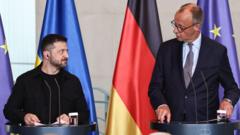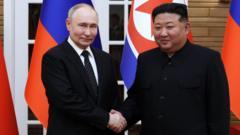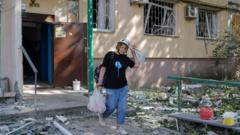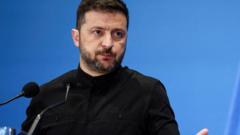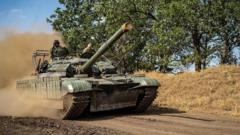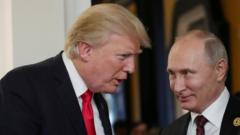### Summary: As Trump and Putin prepare for their Alaska summit, concerns grow over possible territorial negotiations that could alter Ukraine's borders. A detailed assessment reveals the complexities of potential land swaps and the implications for both nations.
### Title: Territorial Integrity vs. Diplomatic Maneuvers: The High Stakes of the Trump-Putin Summit
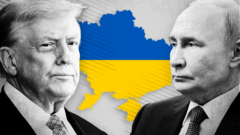
### Title: Territorial Integrity vs. Diplomatic Maneuvers: The High Stakes of the Trump-Putin Summit
### Description: Amid rising tensions, the upcoming Trump-Putin summit in Alaska raises critical questions about Ukraine's territorial integrity and the future of Russian-occupied regions.
In a pivotal moment for Ukraine, former US President Donald Trump and Russian President Vladimir Putin are scheduled to meet in Alaska this Friday, stirring speculation about the future of Ukrainian territory amidst ongoing conflicts. Since 2014, Russia has aggressively asserted control over parts of Ukraine, commencing with the annexation of Crimea and proceeding to support separatist factions in the Donbas region.
The conflict escalated dramatically in February 2022, when Putin launched a full-scale invasion that saw Russian troops advancing deep into Ukrainian territory. Despite initial successes, recent assessments indicate that Russian control has dwindled from about 27% of Ukraine in early 2022 to around 20% today, as Ukrainian resistance remains staunch.
Ukrainian President Volodymyr Zelensky has called for an unconditional ceasefire, a sentiment echoed by European allies. However, Trump’s recent comments concerning possible territorial swaps have ignited apprehension in Kyiv and among frontline European nations. The specifics of these potential land exchanges are shrouded in ambiguity, considering that legally, all contested territories remain part of Ukraine.
As we look towards the end of 2025, territorial maps indicate that Russia continues to desire control over all of Luhansk and Donetsk, regions that have already seen tremendous loss of life among Ukrainian soldiers and civilians. Any concession of these areas from Ukraine would represent a substantial defeat in the eyes of its government and public.
Meanwhile, reports suggest that Russian advances near Dobropillya may signal a show of strength to leverage negotiations with Trump. As territorial discussions loom on the horizon, questions arise about regions acquired in 2022, particularly Zaporizhzhia and Kherson. While rumors circulate about a potential halt in Russian military operations, the practicality of any territory being returned to Ukraine remains doubtful.
The territory surrounding the Sea of Azov and the Black Sea is critical for Russia's strategic aims, complicating the prospect of a reconciliatory stance from Moscow. Putin's previous annexations through disputed referendums have further entrenched these areas in Russia’s plans.
Currently, discussions about border adjustments are premature and fraught with challenges. For Ukraine and its European allies, the notion of "territorial swaps" poses significant risks and is seen as a non-starter. The priority remains the cessation of hostilities and solidifying Ukraine's security before any territorial talks can credibly commence. As the world watches, the stakes couldn't be higher for the future stability of Ukraine and the region.

